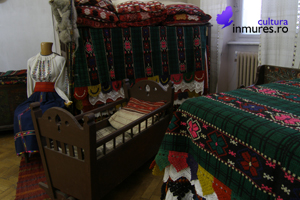
The Ethnography Museum
The origins of the Museum of Ethnography are directly linked to the activity of Aurel Filimon who was deeply involved in the research of the Romanians' material culture. He was a passionate collector of archaeological and ethnographical material. He began his activity in Tîrgu-Mureș in 1918 as a librarian. After several years of close connections with the villages on the Mures valley, he set up the first exhibition of Romanian and Seklar folk art in two halls of the Palace of Culture. During the 1920s Filimon made several official attempts to establish a museum, in the true sense of the word. In 1927 he wrote in a memorandum: “The county is inhabited by Romanians, Hungarians and Germans. To collect the objects used by them in their day-to-day lives is, first of all, to maintain the present for the future, so that the past may be known in the future; secondly, ethnography is proof that the shapes and objects of the antiquity were maintained to this day, thus proving the continuity, adaptation and influence of one people over another". He, at the same time, continued to research the material vestiges of the past. The Museum of Archaeology and Ethnography of Tîrgu-Mureș would open its gates to the public only in 1934, having a permanent exhibition. The ethnographic material were clothing items, tools, and domestic objects, decorated dowry chests, icons painted on glass and wood etc. The success of the permanent exhibition gave Filimon the opportunity of taking part in international exhibitions such as the one in Paris in 1937 or the one in New York in 1939. In 1940, the permanent ethnographical exhibition was closed as a result of the instauration of the Horthy regime. The Ethnography Museum, as it is today, was re-opened in 1984 with an exhibition entitled: “Age, unity, continuity, originality in the ethnography and folk art of the Mureș County”. The exhibition was an expression of interculturality and of the cohabitation between various nationalities: Romanians, Hungarians, Germans, Rrom. More than 6000 objects representative for the area of the Upper Mureș, the Transylvanian Field and the Târnava Valley are preserved. The building of the Museum of Ethnography, the Toldalagi Palace, is in itself an architectural monument representative for the provincial Baroque. Its eight halls are arranged by themes: settlements, households, houses, basic trades, secondary trades, crafts, costumes. The exhibits date from the end of the 19th century and the beginning of the 20th century. Among the most valuable are the vases in clay rolls, sundials, grooms' rings, sculpted dowry chests, decorated shepherds' canes. In addition to its main exhibition, the museum also provides spaces for temporary exhibitions. In the winter period, thematic soirees are organized aiming to revive the atmosphere and customs of the past.
Bibliography:
Aurelia Diaconescu, Dovezi ale trecutului la Muzeul Etnografic in vol. Tîrgu-Mureș, oraș al artelor, published by the Tîrgu-Mureș City Hall in cooperation with the "Vatra" review, pp.119-136.
Aurelia Veronica Filimon, Consacrare și destin în vol. Aurel Filimon – consacrare și destin, volume published by Mureș County Library and the "Vasile Netea" Cultural Foundation, Tîrgu-Mureș, 2001, pp. 20-40.

